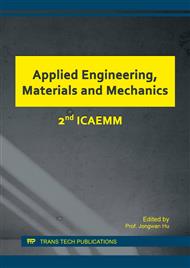[1]
R. M. Rasal, A. V. Janorkar, D. E. Hirt. Poly (lactic acid) modifications. Prog. Polym. Sci. 35(3) (2010) 338-356.
DOI: 10.1016/j.progpolymsci.2009.12.003
Google Scholar
[2]
L. T. Lim, R. Auras, M. Rubino. Processing technologies for poly (lactic acid). Prog. Polym. Sci. 33(8) (2010) 820-852.
DOI: 10.1016/j.progpolymsci.2008.05.004
Google Scholar
[3]
A. J. Lasprilla, G. A. Martinez, B. H. Lunelli, A. L. Jardini, R. Maciel Filho, Poly-lactic acid synthesis for application in biomedical devices—A review. Biotech. Adv. 30(1) (2012) 321-328.
DOI: 10.1016/j.biotechadv.2011.06.019
Google Scholar
[4]
F. Carrasco, P. Pagès, J. Gámez-Pérez, O. O. Santana, M. L. Maspoch. Processing of poly(lactic acid) Characterization of chemical structure, thermal stability and mechanical properties. Polym. Degr. Stabil. 95(2) (2010) 116-125.
DOI: 10.1016/j.polymdegradstab.2009.11.045
Google Scholar
[5]
D. Garlotta. A literature review of poly (lactic acid). J. Polym. Envir. 9(2) (2001) 63-84.
Google Scholar
[6]
J. Tuominen, J. V. Seppala. Synthesis and characterization of lactic acid based poly(ester-amide). Macromol. 33(10) (2000) 3530-3535.
DOI: 10.1021/ma991676l
Google Scholar
[7]
J. S. Wiggins, M. K. Hassan, K. A. Mauritz, R. F. Storey. Hydrolytic degradation of poly(d, l -lactide) as a function of end group: Carboxylic acid vs. hydroxyl. Polym. 47(6) (2006) 1960-(1969).
DOI: 10.1016/j.polymer.2006.01.021
Google Scholar
[8]
Y. Zhang, X. L. Wang, Y. Z. Wang, M. H. Qu. Microwave-assisted single-step synthesis of poly(L-lactic acid)-poly(ethylene glycol) copolymers. J. Macromol. Sci. Part A, 46(6) (2009) 631-635.
DOI: 10.1080/10601320902851991
Google Scholar
[9]
K. D. Nelson, A. Romero, P. Waggoner, B. Crow, A. Borneman, G. M. Smith. Technique paper for wet-spinning poly(L-lactic acid) and poly(D, L-lactide-co-glycolide) monofilament fibers. Tissue Eng. 9(6) (2003) 1323-1330.
DOI: 10.1089/10763270360728233
Google Scholar
[10]
T. Kemala, E. Budianto, B. Soegiyono. Preparation and characterization of microspheres based on blend of poly(lactic acid) and poly(ɛ-caprolactone) with poly(vinyl alcohol) as emulsifier. Arabian J. Chem. 5(1) (2012) 103-108.
DOI: 10.1016/j.arabjc.2010.08.003
Google Scholar
[11]
H Fukuzaki, Y Aiba, M Yoshida, M Asano, M Kumakura. Synthesis of biodegradable poly(L-lactic acid-co-D, L-mandelic acid) with relatively low molecular weight. Die makromol. Chem. 190(10) (2003) 2407-2415.
DOI: 10.1002/macp.1989.021901007
Google Scholar
[12]
H. Fukuzaki, M. Yoshida, M. Asano, et al. Synthesis of low-molecular-weight copoly( l -lactic acid/ɛ-caprolactone) by direct copolycondensation in the absence of catalysts, and enzymatic degradation of the polymers. Polym. 31(10) (1990).
DOI: 10.1016/0032-3861(90)90031-s
Google Scholar
[13]
T. Shimanouchi, S. Ueno, K. Shidahara, Y. Kimura. Rapid conversion of glycerol to lactic acid under alkaline hydrothermal conditions, by using a continuous flow reaction system. Chem. Lett. 43(4) (2014) 535-537.
DOI: 10.1246/cl.131160
Google Scholar
[14]
K. Hiltunen, M. Härkönen, J. V. Seppälä, T. Väänänen. Synthesis and characterization of lactic acid based telechelic prepolymers. Macromol. 29(27) (1996) 8677-8682.
DOI: 10.1021/ma960402k
Google Scholar
[15]
X. L. Lu, X. Q. Lv, Z. J. Sun, Y. F. Zheng. Nanocomposites of poly (l-lactide) and surface-grafted TiO 2 nanoparticles: synthesis and characterization. European Polym. J. 44(8) (2008) 2476-2481.
DOI: 10.1016/j.eurpolymj.2008.06.002
Google Scholar
[16]
H. H. Chuah, D. Lin-Vien, U. Soni. Poly(trimethylene terephthalate) molecular weight and aark–houwink equation. Polym. 42(16) (2001) 7137-7139.
DOI: 10.1016/s0032-3861(01)00043-x
Google Scholar
[17]
J. Zhang, S. B. Yang, D. Han. Comparison of tin and its two chemical compounds as catalyst in direct polycondensation process of polylactic acid. Chem. Bioeng. 27(1) (2001) 30-32.
Google Scholar
[18]
J. Kylmä, J. Tuominen, A. Helminen, J. Seppälä. Chain extending of lactic acid oligomers. Effect of 2, 2'-bis(2-oxazoline) on 1, 6-hexamethylene diisocyanate linking reaction. Polym. 42(8) (2001) 3333-3343.
DOI: 10.1016/s0032-3861(00)00751-5
Google Scholar
[19]
J. S. Liu, C. Peizhen, H. H. Jiang, L. B. Chen. Synthesis and chain extension of hydroxyl-terminated poly(lactic acid) oligomers and application in the blends. Poly1m. Comp. 34(2) (2013) 305-312.
DOI: 10.1002/pc.22406
Google Scholar


